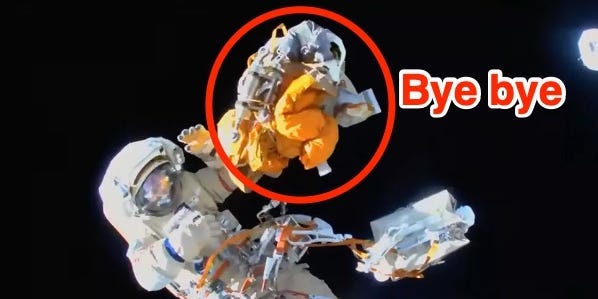- Astronauts threw a bag of leftovers into space during last week’s spacewalk.
- Technically, it’s space junk. But NASA says throwing the bag into space is harmless.
- The bag does not spend much time in orbit and soon burns up in the Earth’s atmosphere.
Last week, cosmonauts Sergei Prokopyev and Dmitry Petelin donned their spacesuits for a 7-hour, 11-minute spacewalk outside the International Space Station.
The spacewalk went smoothly and was a success, but that’s not why these astronauts got attention.
About 6.5 hours into the spacewalk, Prokopiev dropped an 11-pound bag of leftover equipment into space. “It flies beautifully,” said the astronaut, as it sped off into the dark void.
Now, if it’s an electrician working on a powerline, if he puts his bag of leftovers in the ditch after work, you call that littering. And some media are asserting here: that Prokopiev did something wrong.
However, NASA tweeted shortly after the incident that the bundle was harmless because it would burn up in Earth’s atmosphere:
-International Space Station (@Space_Station) May 4, 2023
The reason for that is different from littering the place. Basically, littering the space means that if someone comes after the electrician, burn the bag and throw away the ashes. Earth’s atmosphere is like our own personal garbage disposal.
It’s not clear how long the bundle will stay in orbit, but since it has no engine to boost itself every few months like satellites, gravity will soon pull it into free fall through the atmosphere, where collisions will burn it up.
“It has a short shelf life in orbit,” NASA tweeted.
-International Space Station (@Space_Station) May 4, 2023
In general, we are not saying that space junk is not a problem. This threatens the lives of those on the ISS and future space exploration as a whole.
Of greatest concern when it comes to space junk are defunct satellites, rocket stages, and other large pieces of unmanipulated metal that can collide in orbit.
Such high-velocity space crashes explode in a vast cloud of debris — thousands of tiny spacecraft rocketing around Earth faster than a bullet. If any pieces of that debris hit an active spacecraft, including the ISS, it could cause serious damage.
Endeavour’s radiator was found to have been hit by space debris after one of its missions. The entrance hole is about 0.25 inches wide and the exit hole is twice as large.
NASA
Older space equipment may break up in orbit as it ages and falls. It also creates high-velocity debris clouds that threaten operational satellites and the ISS.
In fact, several times a year the space station fires its booster to get out of the way of incoming orbital debris — and for good reason.
NASA/Canadian Space Agency
According to NASA, hitting a 10-centimeter sphere of aluminum in orbit is the same as detonating 15 pounds of TNT. Colored blobs orbiting Earth have also damaged the spacecraft’s windows.
Image of the chip in the ISS cupola taken by ESA astronaut Tim Peake in April 2016
ESA/NASA
Occasionally, a piece of space junk weighing at least 1 ton falls out of orbit, too big to burn, and lands somewhere on Earth.
Fortunately, most of the planet is water and only some land consists of buildings and people. The chances of falling space junk causing injury or property damage are very low, but they are slowly creeping up as more and more stuff is launched into orbit.
But a small bag like the one thrown by Prokopiev isn’t a concern because it quickly orbits and burns up without a trace in Earth’s atmosphere.
During the spacewalk, Prokopyev and Petelin completed their main mission of moving an airlock to the Russian module on the ISS that would help deploy future Russian experiments and small satellites. The two astronauts are scheduled to complete another spacewalk this Friday.
#Watch #moment #astronaut #throws #bag #parts #space #space #junk #harmless #NASA
